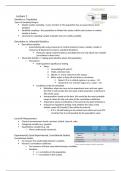Summary
Correlational Research Methods - Summary, Tilburg University
- Course
- Institution
A summary of the course Correlational Research Methods. The summary consists of the lectures given. If you have any questions, you can message me :)
[Show more]




